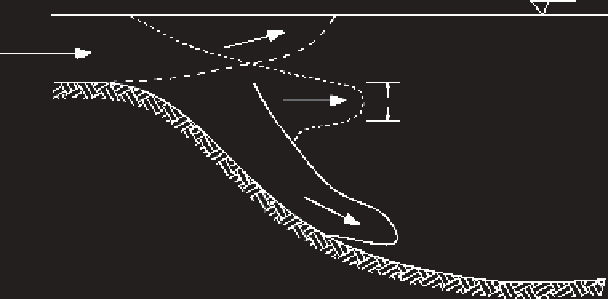Environmental Engineering Reference
In-Depth Information
The transition zone is characterized by the transition from riverinelike to lakelike characteristics.
In this zone, buoyancy forces due to differences in the densities between inlows and lake waters
begin to dominate the advective forces of the inlows. With decreased velocities, denser particles
settle. As the initial kinetic energy of the inlows is dissipated, the potential energy of the inlows,
due to the density differences between the inlows and the lake waters, begins to dominate trans-
port. If the inlow energy is not strong enough to eliminate those density differences (e.g., cause
complete mixing), then the inlow will low to a layer of an equivalent density level and move along
that layer. Where density differences result from differences in temperature or dissolved materials,
they are referred to as density currents. However, if the density differences result from particulate
loads, they are more correctly referred to as turbidity currents (Smith 1975).
If the river water is less dense (more buoyant) than the surface waters of the lake or reservoir, the
more buoyant river water will low over the top of the reservoir water as an overlow (Figure 13.10).
Overlows are common in the springtime, for example, when shallower river waters generally heat
more rapidly (become less dense) than reservoir waters. Overlows also result from thermal dis-
charges. The underside of the overlow is a surface of discontinuity (due to velocity and density
differences), where eddy mixing and the entrainment of reservoir waters occur. The degree of mix-
ing and entrainment is largely controlled by the magnitude of the lows and the density differences.
Overlows may contribute substantially to water quality variations since they add materials
directly to the more productive surface zones of the lake or reservoir (Ford and Johnson 1986).
Since overlows will tend to move over the top of the reservoir waters, the increased water-surface
elevation will result in a hydrostatic instability, which will tend to cause the overlow to quickly
spread out as it moves down-reservoir. The actual amount of spreading that may occur will be
inluenced by processes such as wind mixing, which may tend to mix the overlow with underlying
waters or “push” it to one side of the reservoir. Surface winds often cause the overlow to be rapidly
dissipated (Smith 1975).
If the density of the river water is greater than the surface water, the negative buoyancy causes
the inlows to plunge beneath the lake or reservoir waters, becoming an underlow (Figure 13.10).
The higher density may result from cooler inlow temperatures or higher concentrations of dissolved
or particulate materials. The point where underlows plunge (the plunge point) or the separation
point where overlows detach from the bottom is the transition point between the turbulent open
channel or riverine inlows and the stratiied lows in lakes and reservoirs (Martin and McCutcheon
1999). Usually, the plunge point is easily located by the foam and loating debris trapped by the
converging currents.
Overflow
Q
in
Inflow
thickness
Interflow
Lacustrine
zone
Underflow
FIGURE 13.10
Entrance of inlows of different density to the lake system. (From Chapra, S.C., Martin,
J.L., and Camacho, R.A., LAKE2K: A modeling framework for simulating lake water quality (Version 2.0),
Documentation and Users Manual, Tufts University, Medford, MA, 2011.)

Search WWH ::

Custom Search